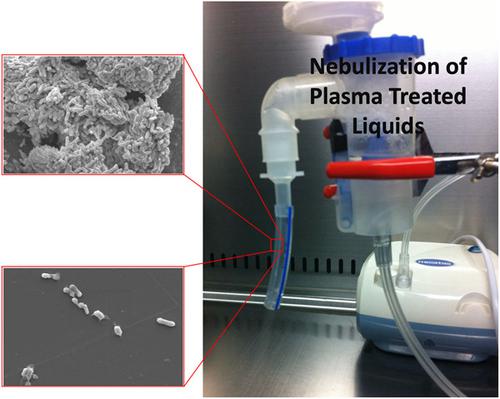当前位置:
X-MOL 学术
›
Plasma Processes Polym.
›
论文详情
Our official English website, www.x-mol.net, welcomes your feedback! (Note: you will need to create a separate account there.)
Inactivation of biofilms in endotracheal tube by cold atmospheric plasma treatment for control and prevention of ventilator‐associated pneumonia
Plasma Processes and Polymers ( IF 3.5 ) Pub Date : 2020-08-26 , DOI: 10.1002/ppap.202000065 Fatma İbiş 1 , Utku K. Ercan 1
Plasma Processes and Polymers ( IF 3.5 ) Pub Date : 2020-08-26 , DOI: 10.1002/ppap.202000065 Fatma İbiş 1 , Utku K. Ercan 1
Affiliation

|
Ventilator‐associated pneumonia (VAP) is a type of hospital‐acquired infection with high mortality and morbidity rates that is seen in critically ill patients who are connected to mechanical ventilators in intensive care units. Conventional infection control measures may remain insufficient for control and prevention of VAP. In the present study, biofilms of most common pathogens, which are responsible for VAP, namely Pseudomonas aeruginosa, Acinetobacter baumannii, Staphylococcus aureus, and Candida albicans, were grown in the lumen of endotracheal tubes (ETs) under low shear to mimic the biofilm formation in clinical settings using the drip flow reactor system. Antibiofilm efficacies of two different plasma treatment methods were tested on the biofilms that were grown in ETs. In the first method, deionized water (DIW), phosphate‐buffered saline (PBS) solution, and N‐acetylcysteine (NAC) solution were treated with air dielectric barrier discharge (DBD) plasma and then nebulized on the biofilms. In the second method, air plasma afterglow (APA), which was generated using a DBD jet electrode, was flown through the lumen of ETs. Effects of two different plasma treatment methods on biofilms were evaluated using colony‐counting and XTT assays. The quantity of extracellular polymeric substance (EPS) was evaluated with the safranin assay. Scanning electron microscopy (SEM) was used to visualize the effect of various plasma treatment methods on biofilms. Cytotoxic effects of two different plasma treatment methods were tested on the human tracheal epithelial cell line. Our results suggest that the nebulized plasma‐treated NAC solution had a superior antibiofilm effect as compared with DIW and PBS. Two different plasma treatment methods used effectively inactivated biofilms and significantly reduced the quantity of EPS without a significant damage to the human tracheal epithelial cell line. Furthermore, SEM images showed the inactivation of microbial cells mainly through membrane damage.
中文翻译:

冷大气等离子体处理可灭活气管插管中的生物膜,从而控制和预防呼吸机相关性肺炎
呼吸机相关性肺炎(VAP)是一种医院获得性感染,具有高死亡率和高发病率,在重症监护病房中与机械通气机相连的危重患者中可以看到。传统的感染控制措施可能仍不足以控制和预防VAP。在本研究中,最常见的病原体生物膜是导致VAP的原因,即铜绿假单胞菌,鲍曼不动杆菌,金黄色葡萄球菌和白色念珠菌使用滴流反应器系统在气管插管(ETs)的内腔中以低剪切力生长,以模仿生物膜的形成。在ET中生长的生物膜上测试了两种不同血浆处理方法的抗生物膜功效。第一种方法是去离子水(DIW),磷酸盐缓冲盐水(PBS)和N‐乙酰半胱氨酸(NAC)溶液用空气电介质阻挡放电(DBD)等离子体处理,然后雾化在生物膜上。在第二种方法中,将使用DBD射流电极产生的空气等离子体余辉(APA)穿过ET的内腔。使用菌落计数和XTT分析评估了两种不同的血浆处理方法对生物膜的影响。用番红素分析法评估细胞外聚合物(EPS)的量。扫描电子显微镜(SEM)用于可视化各种等离子体处理方法对生物膜的影响。测试了两种不同血浆处理方法对人气管上皮细胞系的细胞毒性作用。我们的结果表明,与DIW和PBS相比,雾化的血浆处理的NAC溶液具有更优异的抗生物膜作用。两种不同的血浆处理方法可有效地灭活生物膜,并显着减少EPS的量,而不会严重破坏人的气管上皮细胞系。此外,SEM图像显示主要通过膜损伤使微生物细胞失活。
更新日期:2020-10-07
中文翻译:

冷大气等离子体处理可灭活气管插管中的生物膜,从而控制和预防呼吸机相关性肺炎
呼吸机相关性肺炎(VAP)是一种医院获得性感染,具有高死亡率和高发病率,在重症监护病房中与机械通气机相连的危重患者中可以看到。传统的感染控制措施可能仍不足以控制和预防VAP。在本研究中,最常见的病原体生物膜是导致VAP的原因,即铜绿假单胞菌,鲍曼不动杆菌,金黄色葡萄球菌和白色念珠菌使用滴流反应器系统在气管插管(ETs)的内腔中以低剪切力生长,以模仿生物膜的形成。在ET中生长的生物膜上测试了两种不同血浆处理方法的抗生物膜功效。第一种方法是去离子水(DIW),磷酸盐缓冲盐水(PBS)和N‐乙酰半胱氨酸(NAC)溶液用空气电介质阻挡放电(DBD)等离子体处理,然后雾化在生物膜上。在第二种方法中,将使用DBD射流电极产生的空气等离子体余辉(APA)穿过ET的内腔。使用菌落计数和XTT分析评估了两种不同的血浆处理方法对生物膜的影响。用番红素分析法评估细胞外聚合物(EPS)的量。扫描电子显微镜(SEM)用于可视化各种等离子体处理方法对生物膜的影响。测试了两种不同血浆处理方法对人气管上皮细胞系的细胞毒性作用。我们的结果表明,与DIW和PBS相比,雾化的血浆处理的NAC溶液具有更优异的抗生物膜作用。两种不同的血浆处理方法可有效地灭活生物膜,并显着减少EPS的量,而不会严重破坏人的气管上皮细胞系。此外,SEM图像显示主要通过膜损伤使微生物细胞失活。



























 京公网安备 11010802027423号
京公网安备 11010802027423号